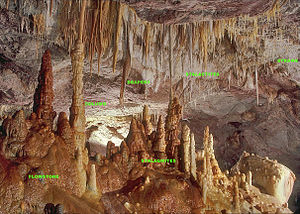
Back Stalaktiet Afrikaans نوازل الكهوف Arabic Stalaktit Azerbaijani Сталактит Bashkir Сталактыт Byelorussian Сталяктыт BE-X-OLD Сталактит Bulgarian Stalaktit BS Estalactita Catalan Brandonu Corsican

A stalactite (UK: /ˈstæləkˌtaɪt/, US: /stəˈlæktaɪt/; from Ancient Greek σταλακτός (stalaktós) 'dripping', from σταλάσσειν (stalássein) 'to drip')[1] is a mineral formation that hangs from the ceiling of caves, hot springs, or man-made structures such as bridges and mines. Any material that is soluble and that can be deposited as a colloid, or is in suspension, or is capable of being melted, may form a stalactite. Stalactites may be composed of lava, minerals, mud, peat, pitch, sand, sinter, and amberat (crystallized urine of pack rats).[2][3] A stalactite is not necessarily a speleothem, though speleothems are the most common form of stalactite because of the abundance of limestone caves.[2][4]
The corresponding formation on the floor of the cave is known as a stalagmite.
- ^ "stalactite". Oxford Dictionary. Archived from the original on August 1, 2021. Retrieved 2021-08-01 – via Lexico.com.
- ^ a b Larson, Charles (1993). An Illustrated Glossary of Lava Tube Features, Bulletin 87, Western Speleological Survey. p. 56.
- ^ Hicks, Forrest L. (1950). "Formation and mineralogy of stalactites and stalagmites" (PDF). 12: 63–72. Retrieved 2013-07-08.
{{cite journal}}: Cite journal requires|journal=(help) - ^ "How Caves Form". Nova (American TV series). Retrieved 2013-07-01.
© MMXXIII Rich X Search. We shall prevail. All rights reserved. Rich X Search